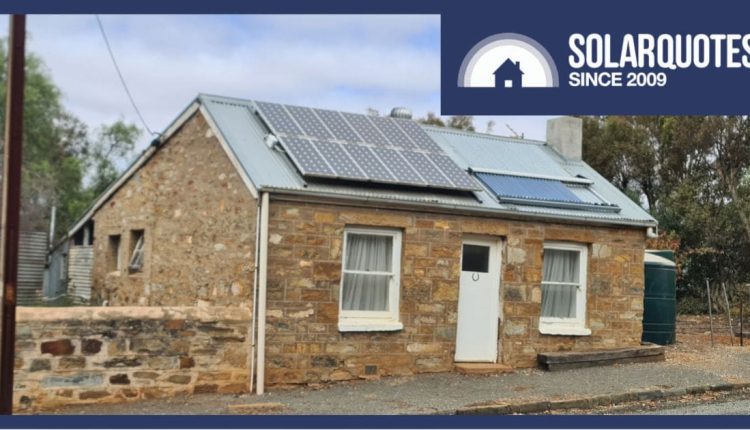How to get solar panels for a heritage home
Old homes are a blessing, but energy efficiency isn’t always a strength.
Can you install solar panels on a home and still retain its historic character? It’s possible, but you may have to appease the neighbors and follow some narrowly worded rules. Read on to find out some good points you can raise to support your planning application.
Do the monument protection rules apply to solar energy?
If your neighborhood has a historic preservation area and you want solar energy, you will likely need to submit an application to the municipality.
Terminology will vary. Is it a contribution building? a local heritage site? A list of state cultural heritage? There are many classifications, but the key question is how important the authorities and local community consider your home to be.
Government House in Adelaide was carefully designed to locate the service area of the Governor’s Residence on the north side. Even the chimneys are ideally placed for solar energy.
What can you see from the street?
My former family doctor sometimes complains about “the trust”. It’s not the Housing Trust (public housing authority) but the National Trust. These people give you a brass plaque and tell you, whether you like it or not, that you can’t paint a grand old house with football colors.
I didn’t have to deal with a pushy planning department or a preservationist who likes to throw his weight around, but I’m glad they get the opportunity to preserve the feel of the place.
Still, there is room for pragmatism, and if you can incorporate “adaptive reuse” into your application, that’s a good sign.
I saw a new shed with a corrugated zinc roof, built with sloping roofs, skylights and details to complement the adjacent wooden shed with its own zinc roof (not galvanized). The council has ordered that the zinc shed roof be painted to match the zinc house roof.
In speaking to a number of local planning departments, the consensus seems to be that if you can’t see it on the street, you’re free to put it in whatever you like.
If you can see the sun from the street, you may still have a lot of paperwork ahead of you. Most states and territories have helpful resources to guide you. However, these do not necessarily cover your local government’s regulations:
The rules of cultural heritage have their place. Located at the back of a large two-story pub for at least 16 years, this stable is proof that even modest utility buildings need protection – now all it needs is solar power.
Integrated approaches
Solar roof tiles have been the next big thing for a few years now, but as far as I can tell they’re just a bit too expensive to be a mainstream product because Australians are cheap.
A heritage tiled roof could be an interesting place for this, provided heritage experts do not rely on the roofing material itself being the intrinsic value they wish to preserve.
Solar tiles are also known as BIPV or building integrated photovoltaics.
Slate tile roofs are difficult to work with. The best way to do this is to have a slater work hand in hand with the solar team on the day of installation. With solar tiles, you may still need a slate roofing expert to incorporate the edging around the edges, but these should not overlap.
The English solar power solution shown below is one I have rarely seen, but it looks very nice for cheap, traditional solar panels.
In the UK they often build with waterproof membranes topped with battens and tiles or cladding to keep out the weather.
An Australian take
A local approach may vary depending on local regulations. The biggest challenge may be finding an interested builder. However, as a trained roofer, I would do the following on my house:
- Remove the existing roofing iron (or tiles).
- Install roof battens between the rafters parallel to the roof purlins at the center points determined by the solar framing system to be used.
- Remove the old roof purlins and cover the top of the rafters with 10mm plywood bracing.
- The thickness or structural specification of the layer would need to be determined, as would the use of an underlayment or condensation control membrane.
- Have your roofer install new flat sheet metal flashing with raised edges to match the original roof plane – in roofing parlance, a giant roof tile or a shallow box gutter, for lack of a better description. This is the waterproof membrane that drains into the gutter and keeps the pests away.
- Install the solar frame and modules. Frame rails need to be fairly flat, perhaps only 30mm high, and attached vertically directly to the paneling using neoprene insulators.
- Finally, the roofers come back with custom flashings to cover the edges of the array, which are firmly attached to the new iron or brick cladding on traditional battens/purlins to prevent leaves and birds from getting underneath.
The value of cultural heritage is hidden in plain sight. It wasn’t until we had difficulty drilling a hole for a wire that we realized we would be mounting the solar array on a wooden shingle roof. Unfortunately, much of this building has been compromised by unsympathetic work.
Adelaide City Council has been quite proactive with grants for residents and a dedicated solar system for the town hall, although the system is invisible from street level.
I wish it was more trendy
I mean, a lot of old houses get a bright white coat of paint with fashionable gray roofs. If solar energy was viewed as a statement rather than an economic failure, we would have more solar energy and less waste left over for hard trash.
It’s not greenwashing or chasing rebates that motivates solar customers to electrify. Not using petrol is a given, electric heating and cooling makes perfect sense and switching to an electric vehicle is probably the best value for money ever.
All of these works require sunshine to power them.
In a recent application I saw, proponents already had the following:
- 5.59 kW east facing panels,
- Supported by a 13.5 kWh Tesla Powerwall 2 storage,
- This means that the house is around 74% self-sufficient in summer.
That’s good, but it’s not enough. As soon as hot water and cooking are powered by electricity, demand increases. And in winter or on cloudy days, your solar system cannot keep up. Therefore, with heritage approval, more west-facing solar installations were sought to make this possible.
Practical needs should outweigh aesthetic arguments
Yes, the application-explained boards are visible from the street. But the power lines, the antennas, the gas meters and, in the summer, the air conditioning systems also drip into the driveways.
In this case, the application noted that Melbourne has already warmed by up to 1.4°C since 1950. Two heat waves lasting several days in 2009 and 2014 killed hundreds of people.
The street’s original design, with shaded setbacks, large blocks, and a backyard outbuilding, was intended to protect amenities and health in the days before antibiotics and air conditioning. However, the environment it was designed for no longer exists.
If we want to preserve the purpose of the heritage area – livable, healthy homes with gardens and social spaces – we must allow these homes to adapt.
To some, adding solar panels to a heritage home may sound like an architectural crime, but what’s really more offensive: clean energy on a roof or climate change slowly boiling the street as your kids ride their bikes down the street?
History is not about freezing time
While planners talk about the value of consistent setbacks, materials and streetscape character, we must remember that it is also about creating and maintaining a pleasant environment. When heat waves kill the trees, dry out the gardens and force residents to retreat indoors with the blinds closed, what heritage are we preserving?
Solar energy helps prevent this by powering the air conditioning and e-bike, meaning you can realistically replace a car in a well-served area.
Solar keeps everything running when the grid collapses under the strain of the urban heat island effect. It is well documented that reliability has continually increased as network utilization has been reduced. Every kilowatt hour generated locally is one less kilowatt hour that has to be pulled through a transformer and released as waste heat on your street.
Strict monument protection regulations run the risk of missing the point
We now have planning clauses that address climate, natural disasters and the need for adaptation. Even the AS1170.2 building standard includes a climate multiplier in the engineering calculations we use for wind loading on solar systems.
If your local authorities say your solar energy can’t be approved just because it’s good for the environment, those same panels will help preserve the landmarks the heritage regulations were written to protect.
In short: They ensure that residents feel comfortable in the houses that everyone likes to see from the outside.
Heritage overlays are seen as more important than the design code, which calls for better environmental standards. We probably need to change that.
You can find further information about what you should consider when purchasing solar modules in our detailed guide.



Comments are closed.